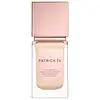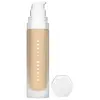Patrick Ta Major Skin Hydra-Luxe Luminous Skin Perfecting Foundation Versus Fenty Beauty Soft’Lit Naturally Luminous Longwear Foundation
What's inside
What's inside
 Key Ingredients
Key Ingredients

 Benefits
Benefits

 Concerns
Concerns

 Ingredients Side-by-side
Ingredients Side-by-side

Water
Skin ConditioningGlycerin
HumectantIsononyl Isononanoate
EmollientPropanediol
SolventDicaprylyl Ether
EmollientSqualane
EmollientPentaerythrityl Tetraisostearate
EmollientHydrogenated Styrene/Methylstyrene/Indene Copolymer
Hydrogenated Ethylhexyl Olivate
EmollientPolyglyceryl-6 Polyricinoleate
EmulsifyingPolyglyceryl-2 Dipolyhydroxystearate
Skin ConditioningIsostearyl Neopentanoate
EmollientC9-12 Alkane
SolventDimer Dilinoleyl Dimer Dilinoleate
EmollientPolyglyceryl-2 Isostearate
EmulsifyingPvp
Emulsion StabilisingLauroyl Lysine
Skin ConditioningDipalmitoyl Hydroxyproline
Skin ConditioningMyristyl Myristate
EmollientMagnesium Sulfate
Disteardimonium Hectorite
StabilisingLecithin
EmollientPhenoxyethanol
PreservativePropylene Carbonate
SolventZinc Stearate
Cosmetic ColorantOctyldodecyl Stearoyl Stearate
EmollientHydrogenated Lecithin
EmulsifyingButyrospermum Parkii Butter
Skin ConditioningSodium Benzoate
MaskingSaccharomyces/Xylinum/Black Tea Ferment
Skin ConditioningDistarch Phosphate
AbsorbentAllantoin
Skin ConditioningHydrogenated Olive Oil Unsaponifiables
EmollientCoco-Caprylate/Caprate
EmollientTocopherol
AntioxidantSodium Hyaluronate
HumectantSodium Dehydroacetate
PreservativeHelianthus Annuus Seed Oil
EmollientPentaerythrityl Tetra-Di-T-Butyl Hydroxyhydrocinnamate
AntioxidantPotassium Sorbate
PreservativeCI 77891
Cosmetic ColorantIron Oxides
Water, Glycerin, Isononyl Isononanoate, Propanediol, Dicaprylyl Ether, Squalane, Pentaerythrityl Tetraisostearate, Hydrogenated Styrene/Methylstyrene/Indene Copolymer, Hydrogenated Ethylhexyl Olivate, Polyglyceryl-6 Polyricinoleate, Polyglyceryl-2 Dipolyhydroxystearate, Isostearyl Neopentanoate, C9-12 Alkane, Dimer Dilinoleyl Dimer Dilinoleate, Polyglyceryl-2 Isostearate, Pvp, Lauroyl Lysine, Dipalmitoyl Hydroxyproline, Myristyl Myristate, Magnesium Sulfate, Disteardimonium Hectorite, Lecithin, Phenoxyethanol, Propylene Carbonate, Zinc Stearate, Octyldodecyl Stearoyl Stearate, Hydrogenated Lecithin, Butyrospermum Parkii Butter, Sodium Benzoate, Saccharomyces/Xylinum/Black Tea Ferment, Distarch Phosphate, Allantoin, Hydrogenated Olive Oil Unsaponifiables, Coco-Caprylate/Caprate, Tocopherol, Sodium Hyaluronate, Sodium Dehydroacetate, Helianthus Annuus Seed Oil, Pentaerythrityl Tetra-Di-T-Butyl Hydroxyhydrocinnamate, Potassium Sorbate, CI 77891, Iron Oxides
Water
Skin ConditioningDimethicone
EmollientButylene Glycol Dicaprylate/Dicaprate
EmollientDiphenylsiloxy Phenyl Trimethicone
Skin ConditioningGlycerin
HumectantSynthetic Fluorphlogopite
Cetyl PEG/PPG-10/1 Dimethicone
EmulsifyingTrisiloxane
Skin ConditioningButylene Glycol
Humectant1,2-Hexanediol
Skin ConditioningTrimethylsiloxysilicate
EmollientDisteardimonium Hectorite
StabilisingPEG-10 Dimethicone
Skin ConditioningPolyphenylsilsesquioxane
Magnesium Sulfate
Dimethicone Crosspolymer
Emulsion StabilisingLauroyl Lysine
Skin ConditioningTriethoxycaprylylsilane
Aluminum Hydroxide
EmollientPolyhydroxystearic Acid
EmulsifyingEthylhexyl Palmitate
EmollientIsopropyl Myristate
EmollientIsostearic Acid
CleansingLecithin
EmollientTerminalia Ferdinandiana Fruit Extract
AntioxidantTrisodium Ethylenediamine Disuccinate
Polyglyceryl-3 Polyricinoleate
EmulsifyingCyperus Rotundus Root Extract
Skin ConditioningCI 77891
Cosmetic ColorantIron Oxides
Water, Dimethicone, Butylene Glycol Dicaprylate/Dicaprate, Diphenylsiloxy Phenyl Trimethicone, Glycerin, Synthetic Fluorphlogopite, Cetyl PEG/PPG-10/1 Dimethicone, Trisiloxane, Butylene Glycol, 1,2-Hexanediol, Trimethylsiloxysilicate, Disteardimonium Hectorite, PEG-10 Dimethicone, Polyphenylsilsesquioxane, Magnesium Sulfate, Dimethicone Crosspolymer, Lauroyl Lysine, Triethoxycaprylylsilane, Aluminum Hydroxide, Polyhydroxystearic Acid, Ethylhexyl Palmitate, Isopropyl Myristate, Isostearic Acid, Lecithin, Terminalia Ferdinandiana Fruit Extract, Trisodium Ethylenediamine Disuccinate, Polyglyceryl-3 Polyricinoleate, Cyperus Rotundus Root Extract, CI 77891, Iron Oxides
 Reviews
Reviews

Ingredients Explained
These ingredients are found in both products.
Ingredients higher up in an ingredient list are typically present in a larger amount.
Ci 77891 is a white pigment from Titanium dioxide. It is naturally found in minerals such as rutile and ilmenite.
It's main function is to add a white color to cosmetics. It can also be mixed with other colors to create different shades.
Ci 77891 is commonly found in sunscreens due to its ability to block UV rays.
Learn more about CI 77891Disteardimonium Hectorite comes from the clay mineral named hectorite. It is used to add thickness to a product.
It can also help stabilize a product by helping to disperse other ingredients.
Hectorite is a rare, white clay mineral.
Learn more about Disteardimonium HectoriteGlycerin is already naturally found in your skin. It helps moisturize and protect your skin.
A study from 2016 found glycerin to be more effective as a humectant than AHAs and hyaluronic acid.
As a humectant, it helps the skin stay hydrated by pulling moisture to your skin. The low molecular weight of glycerin allows it to pull moisture into the deeper layers of your skin.
Hydrated skin improves your skin barrier; Your skin barrier helps protect against irritants and bacteria.
Glycerin has also been found to have antimicrobial and antiviral properties. Due to these properties, glycerin is often used in wound and burn treatments.
In cosmetics, glycerin is usually derived from plants such as soybean or palm. However, it can also be sourced from animals, such as tallow or animal fat.
This ingredient is organic, colorless, odorless, and non-toxic.
Glycerin is the name for this ingredient in American English. British English uses Glycerol/Glycerine.
Learn more about GlycerinThis ingredient comes from a fatty acid (lauric acid) and amino acid (lysine). It is used to add a silky feel to cosmetics.
According to a manufacturer, its fatty acid base leaves a silky feeling on the skin. It also has emollient properties because of this. Emollients help soften skin by preventing water from evaporating.
Lauroyl lysine is barely soluble in water.
Learn more about Lauroyl LysineLecithin is a term for a group of substances found in the cell membranes of plants, animals, and humans. They are made up of mixture of phospholipids.
This ingredient has emollient and emulsifying properties.
As an emollient, lecithen helps soften the skin and creates a barrier to keep moisture in.
As an emulsifier, it also helps prevent water and oil ingredients from separating. Lecithin can also help ingredients be better absorbed by the skin.
This is because the phospholipids in lecithin produce liposomes. Liposomes help other ingredients get through the skin barrier.
Depending on the source of this ingredient, lecithin may not be fungal acne safe. This is because some sources of lecithin come from soybean oil, which may feed the malassezia yeast that feeds fungal acne.
We recommend reaching out to the brand you are purchasing from to inquire about the source of their lecithin.
Some other names for this ingredient include soy lecithin and deoiled soy lecithin.
Learn more about LecithinMagnesium Sulfate is a salt. More specifically, it is an epsom salt, or the bath salt used to help relieve muscle aches.
Despite having ‘sulfate’ in the name, it isn’t a surfactant or cleansing agent like sodium lauryl sulfate. Unlike those sulfates, magnesium sulfate doesn’t have the same cleansing or foaming properties (it's simply a type of salt).
In cosmetics, Magnesium Sulfate is used to thicken a product or help dilute other solids. It is a non-reactive and non-irritating ingredient.
One study shows magnesium deficiency may lead to inflammation of the skin. Applying magnesium topically may help reduce inflammation.
You can find this ingredient in sea water or mineral deposits.
Learn more about Magnesium SulfateWater. It's the most common cosmetic ingredient of all. You'll usually see it at the top of ingredient lists, meaning that it makes up the largest part of the product.
So why is it so popular? Water most often acts as a solvent - this means that it helps dissolve other ingredients into the formulation.
You'll also recognize water as that liquid we all need to stay alive. If you see this, drink a glass of water. Stay hydrated!
Learn more about WaterThis ingredient is a combination of red, black, and yellow iron oxide pigments. This combination of colors is usually found in foundation, because it results in a "skin" color.